Enveloped by lush rainforests, bordered by golden beaches, crowned with ancient volcanoes, and dotted with the ruins of forgotten civilizations—this is Southeast Asia just as you’ve always dreamed it.
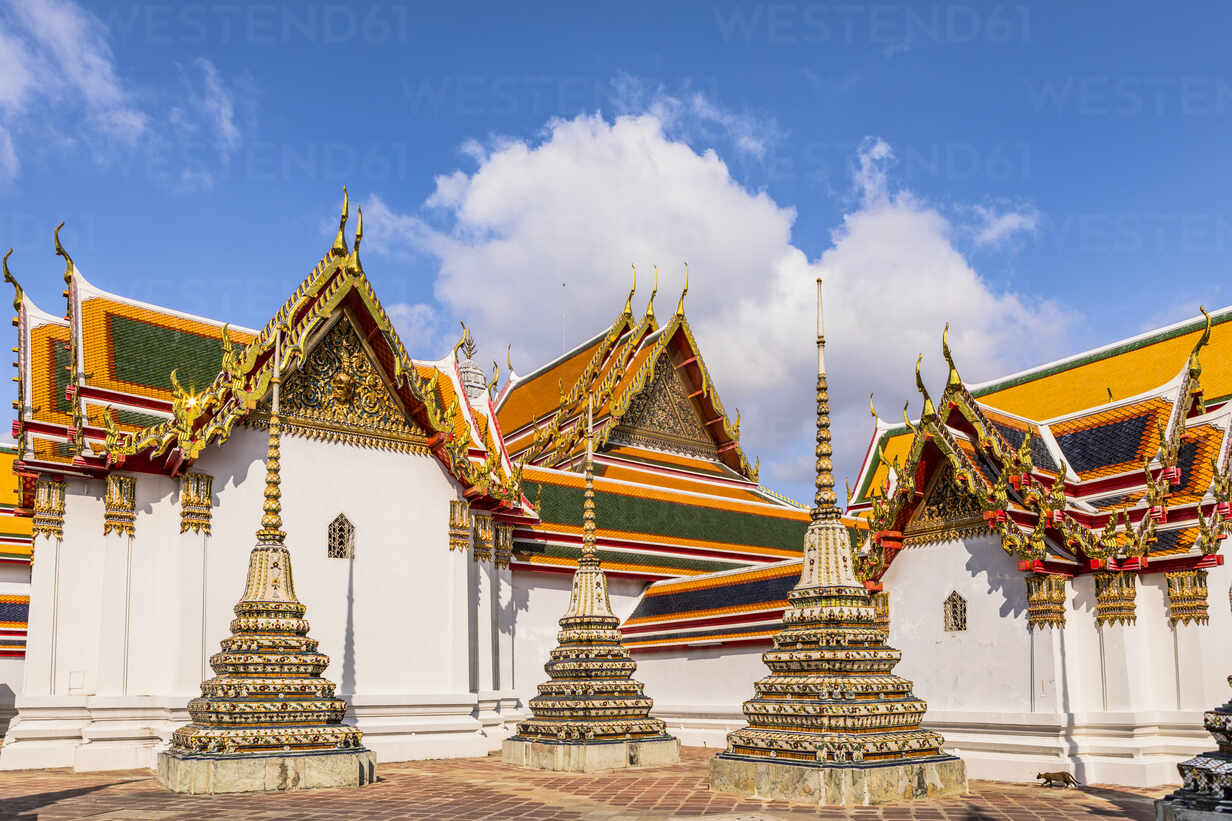
Wat Pho is easily one of our top picks among Bangkok’s major sights, and with good reason. It’s home to some impressive superlatives: the city’s largest reclining Buddha, Thailand’s largest collection of Buddha images, and the country’s earliest public education center.
The Reclining Buddha
The showstopper here is the immense 46-meter-long, 15-meter-high Reclining Buddha, representing the Buddha’s entry into Nirvana. Its feet are adorned with intricate mother-of-pearl inlays depicting the 108 auspicious signs of the Buddha. Behind the statue are 108 monk bowls—drop a coin in each for good luck. Don’t worry if you’re short on change; attendants will happily exchange notes for coins.
Phra Ubosot (Ordination Hall)
Originally built during the reign of Rama I and later restored by Rama III, this sacred hall houses Phra Buddha Deva Patimakorn—an iconic seated Buddha—and the ashes of Rama I. The richly detailed murals and three-tiered pedestal reflect Ayuthaya influences.
Galleries & Buddha Images
Wander through galleries lined with over 394 gilded Buddha statues showcasing nearly every Thai artistic style, from Lopburi to Rattanakosin. The Phra Chinnarat and Phra Chinnasri images in the western and southern wí·hăhn (chapels) are especially noteworthy, rescued from Sukhothai by Rama I’s relatives.
Stone Inscriptions & Thai Massage
Wat Pho served as Thailand’s first public university. King Rama III added over 1400 stone inscriptions between 1831–1841 covering subjects like medicine, literature, and massage. These are now recognized by UNESCO. Thai massage is still taught and practiced here, with two pavilions within the compound and training rooms nearby. One-day and 5-day massage courses are available, starting at 12,000B.
Royal Chedi & Phra Mondop
Marvel at the four towering chedi, each dedicated to the first four Chakri kings. The square-bell design and colorful tiles reflect Rattanakosin style. Nearby, the elevated scripture hall, Phra Mondop, is guarded by yaksha (mythical giants) and surrounded by fascinating legends.
The Grounds
Don’t miss the whimsical rock gardens, tranquil courtyards, and quirky granite statues—many originally used as ship ballast from China. Spot the yoga hermit Khao Mor and even a statue of Marco Polo! The sacred Bodhi tree, grown from the one under which the Buddha attained enlightenment, gives the temple its nickname: Wat Pho.
16th Century: Originally known as Wat Phodharam, built in the late Ayuthaya period.
1788: Restored by Rama I after establishing Bangkok as the capital.
1832–1848: Major expansions and the construction of the Reclining Buddha under Rama III.
1982: Restored again for the Bangkok Bicentennial.
Opening Hours: Daily, 8:30 AM to 6:30 PM
Admission: 200B (includes a free bottle of water, collect near Reclining Buddha)
Dress Code: Modest attire (long pants/skirt, sleeved tops). Shoes must be removed and carried in a provided plastic bag.
Where else can you get a massage in a UNESCO-recognized temple? Book ahead through the Wat Pho Thai Traditional Massage School website. Both foot and Thai massages (30 or 60 mins) are available. Courses are offered daily except Sunday at a nearby restored shophouse in Soi Phen Phat.
Arrive Early: Avoid crowds and take advantage of cooler morning weather.
Don’t Rush: Explore beyond the Reclining Buddha—the temple grounds are vast and filled with lesser-known gems.
Pa Aew: A simple, open-air spot for flavorful Bangkok-style curries and stir-fries.
Tonkin Annam: Top-notch Vietnamese food, including banana blossom salad, pho, and Hue specialties like bánh bèo.
Chakrabongse Villas: A luxurious riverside retreat in a royal palace setting with lush gardens and river-view suites.
Arun Residence: Just across from Wat Arun, this charming wooden house offers stylish rooms, a rooftop bar, and a cozy vibe.
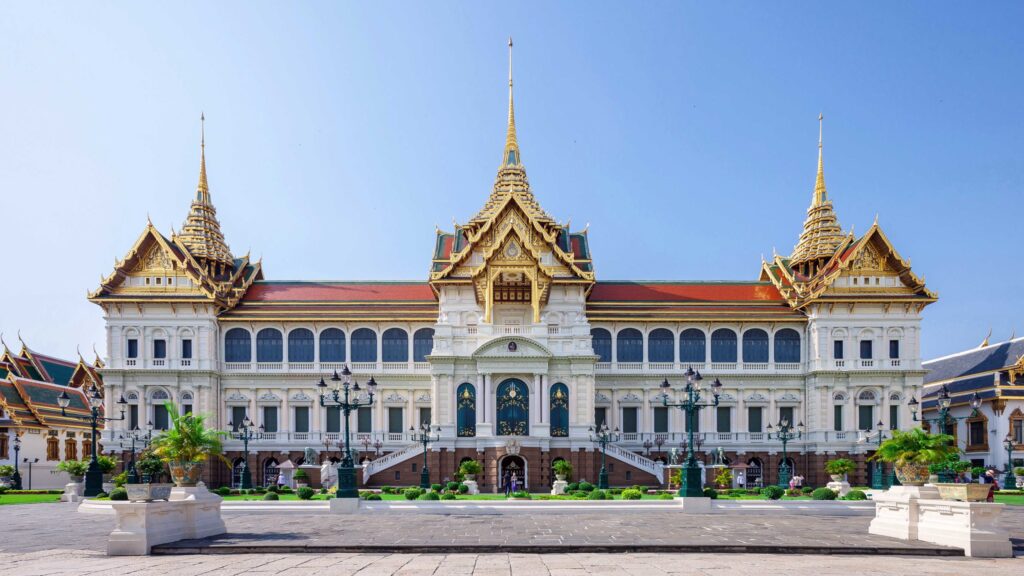
The Grand Palace, or Phra Borom Maharatchawang, has been a symbol of Thailand’s royal heritage since its consecration in 1782. Though no longer used as a royal residence, it continues to host important ceremonial events and remains Bangkok’s most visited landmark, drawing both tourists and devout Buddhists alike.
Part of a vast complex that includes Wat Phra Kaew (the Temple of the Emerald Buddha), the Grand Palace covers an area of 94.5 hectares and includes over 100 buildings. Together, they represent more than two centuries of royal history and evolving architectural styles, predominantly Ratanakosin, the classic old-Bangkok aesthetic.
Visitors can explore the palace grounds and four of the preserved buildings. To fully appreciate the site, plan for two to three hours—or longer with a guide.
One of the most prominent buildings open to the public is the Chakri Mahaprasat Hall. Completed in 1882 by British architect John Clunish, the hall features a unique mix of Italian Renaissance design and traditional Thai roofs. The architectural style is often described as “Westerner in a Thai dancer’s headdress” due to its blend of Western structure with Thai mon·dòp (tiered spires). Legend suggests the original dome design was replaced at the request of King Rama V, symbolically asserting Thai sovereignty amid European colonial influence.
The central spire holds the ashes of Chakri dynasty kings, while the flanking ones enshrine princes who never acceded to the throne. Nearby, the Dusit Hall, built in traditional Ratanakosin style, served both as an audience hall and a funerary chamber.
To the east, Borombhiman Hall—designed in a French style—was the residence of King Rama VI and is now only visible through iron gates. On the western side stands Amarindra Hall, a rarely used ceremonial space for coronations and formerly a court of justice.
Historically, the inner palace was home to the king’s harem, guarded by specially trained female sentries. Although closed to the public, its legacy is preserved in literature such as Kukrit Pramoj’s Four Reigns, which follows life inside the royal city through the eyes of a young girl named Phloi.
The Grand Palace was established in 1782 by King Rama I after relocating the royal court from Thonburi to the eastern bank of the Chao Phraya River. The river provided natural defense on three sides, while the eastern delta was difficult for enemies to cross undetected.
Over time, the royal family moved out of the Grand Palace, and Chakri Mahaprasat Hall fell into disrepair. A renovation project launched in 1932 under King Rama VII ran out of funds, leading to the partial demolition of the structure.
The palace has also witnessed significant modern events. King Rama VIII was mysteriously found dead here in 1946. In 1981, the palace became the base for an unsuccessful military coup. More recently, in 2017, it served as the site for the elaborate state funeral of King Rama IX, which included a 50-meter-high cremation pyre and drew tens of thousands of mourners. King Rama X held his coronation here in 2019, continuing the legacy of royal rites within these walls.
To enter the Grand Palace, visitors must dress modestly. This includes long pants or skirts and sleeved shirts that cover the shoulders. Items such as sleeveless tops, vests, shorts, see-through garments, tight trousers, cycling shorts, or miniskirts are not allowed.
Those not dressed appropriately will be required to borrow a sarong from a designated dressing area at the entrance, which may cause delays.
There are no restrictions on footwear, but shoes must be removed before entering some buildings.
Opening hours: Daily, 8:30 am to 3:30 pm
Entry: 500 baht (includes access to Wat Phra Kaew and the Queen Sirikit Museum). Thai nationals enter free.
Tickets can be bought at the gate or online via the official Royal Grand Palace website.
Audio guides are available for rent (200 baht), and personal guides can be hired on-site.
The site is wheelchair accessible, with ramps and accessible restrooms.
Arrive early to avoid crowds and midday heat.
Beware of touts outside the palace claiming that parts of the site are closed—they’re not.
Bring drinking water, as there is little shade and the onsite cafeteria is often closed.
Ming Lee: A classic Thai restaurant located just across from the main entrance, perfect for a quick and satisfying lunch.
Navy Club: Offers simple seafood dishes at affordable prices and a rare riverfront view, though the setting is more functional than elegant.
Asadang: An atmospheric antique shophouse in Chinatown with nine character-filled rooms and modern comforts.
Feung Nakorn Balcony: Set in a former school, its spacious rooms overlook a tranquil garden courtyard. A peaceful retreat away from the traffic.
Arom D: Located in the lively Tien Village area, this boutique guesthouse offers playful design, communal spaces, and a rooftop deck with views.
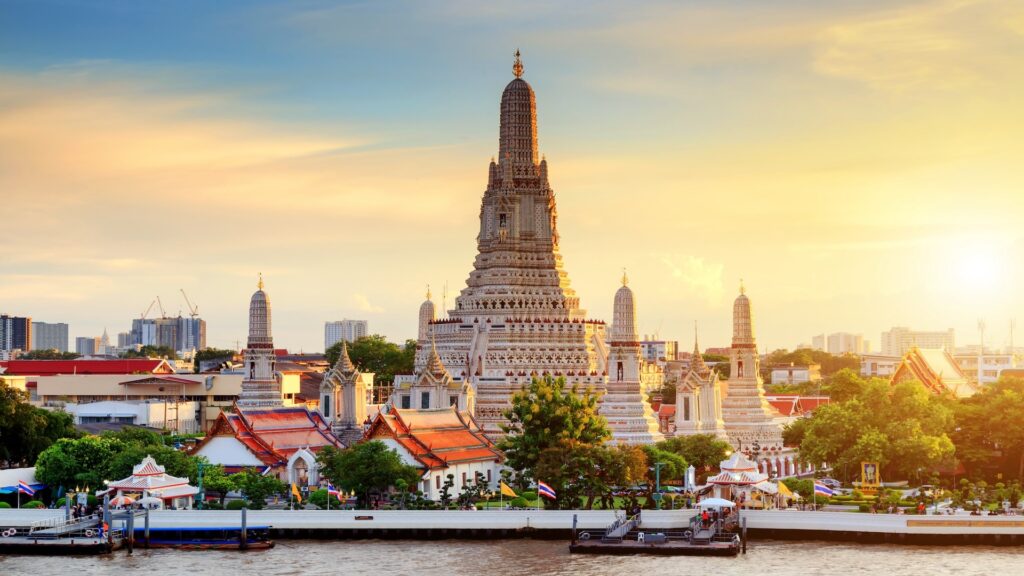
Rising like a celestial spear from the western bank of the Chao Phraya River, Wat Arun, or the Temple of Dawn, is one of Bangkok’s most recognisable landmarks. Named after Arun, the Indian god of dawn, the temple gained prominence when King Taksin stumbled upon it at sunrise after the fall of Ayuthaya in 1767. Interpreting the moment as auspicious, he declared the site sacred and later established it as part of the new capital.
Today, Wat Arun is not only a cherished spiritual site but also one of the few Buddhist temples in Thailand that encourages visitors to climb its towering central spire for panoramic views of Bangkok.
What to See
The Central Spire
The temple’s defining feature is its 82-metre-high Khmer-style tower, or pra prang, constructed during the reigns of Rama II and Rama III in the 19th century. Up close, the tower reveals a mesmerising mosaic of colourful floral patterns, crafted from shards of Chinese porcelain once used as ballast by merchant ships. Steep stairways lead to terraces offering sweeping views of the Chao Phraya River and the city skyline.
The Ordination Hall
Wat Arun’s bòht (ordination hall) houses a Buddha image believed to have been designed by Rama II himself. The interior walls are adorned with murals from the reign of Rama V, most notably a scene depicting Prince Siddhartha’s encounters with aging, sickness, and death—experiences that set him on the path to enlightenment.
Temple Grounds
The temple compound includes several other noteworthy structures, including two wihan (sanctuaries), a hor trai (scripture library), and six sala (pavilions) beside the river. Traditionally used as resting areas or for study, the sala now also serve as docks for arriving tourist boats.
History
The earliest records of a temple on this site date back to the late 16th century, when it was known as Wat Makok. After King Taksin’s arrival at sunrise, the site was renamed Wat Chaeng and briefly housed the revered Emerald Buddha, which has since been relocated to Wat Phra Kaew.
The temple was renamed Wat Arun under Rama II, who began enlarging the central spire. Construction was completed in 1842 under Rama III. Aside from restoration work completed in 2017, the temple remains much the same as it did nearly two centuries ago.
Tickets and Practical Info
Wat Arun is open daily from 8 am to 6 pm. Entry costs 50 baht. The main entrance is just off Th Arun Amarin. Though many visitors arrive via long-tail boat tours, it’s simple and affordable to reach the temple using the Chao Phraya Express Boat or the cross-river ferry from Tien Pier, which runs from 5 am to 9 pm.
Dress Code
As with all Buddhist temples, modest dress is required. This means no sleeveless tops, short skirts, or see-through clothing. Visitors wearing inappropriate attire will be asked to rent a sarong for 20 baht, with a refundable deposit of 100 baht. Shoes must be removed when entering certain buildings.
Best Time to Visit
Wat Arun is especially striking in the late afternoon when the western sun illuminates the temple and the river behind it. For sunset photography, cross the river to Th Maha Rat, where warehouses-turned-viewpoints offer the perfect vantage. A small “viewing fee” may be requested by locals. Around 7 pm, the temple lights are switched on, adding magic to the twilight scene.
Nearby Dining
For a midday meal, Tonkin Annam offers delicious Vietnamese cuisine just across the river. For sunset drinks or dinner with a view, consider The Rooftop or Amorosa, both of which have panoramic perspectives of the temple from across the water.
Where to Stay
Arun Residence offers unbeatable views of Wat Arun from its multi-level riverside structure. With just seven rooms, it combines antique charm with modern comforts, plus communal areas like a library, rooftop bar, and restaurant.
Sala Ratanakosin is a contemporary option with open-plan rooms, large windows, and sleek, minimalist interiors. Though compact, the rooms appeal to design-conscious travellers and boast direct views of the temple and river.

Consecrated in 1782 alongside the founding of Bangkok, this historically layered complex—comprising Wat Phra Kaew (Temple of the Emerald Buddha) and the former royal residence—remains Thailand’s most sacred site and its top tourist destination. The 94.5-hectare grounds contain over 100 buildings that reflect two centuries of dynastic history and architectural evolution.
The Emerald Buddha
First Impression: Upon entering, you’re greeted by towering yaksha guardians from the Ramakian epic.
The Statue: Nestled inside the richly ornamented ordination hall, the Emerald Buddha measures just 66 cm but commands reverent attention. Its ornate gilded shrine can easily overshadow the small figure it protects.
Origins & Seasons: First appearing in 15th-century Chiang Rai, the statue dates stylistically to the 13th–14th centuries. A seasonal wardrobe—hot, rainy, and cool—is ceremonially changed by the king at the start of each period, emphasizing its royal significance.
Ramakian Murals & Phantom Figures
Cloister Path: A 2 km circuit of murals traces the Ramakian story in vivid color and narrative detail. Start at the north gate and proceed clockwise to follow Rama’s saga—from exile and Sita’s abduction to his alliance with Hanuman and the dramatic rescue.
Quiet Corners: Unlike the bustling temple halls, the mural gallery offers a shaded, contemplative space away from the crowds.
Phra Mondop and Prasat Structures
Built under King Rama I, Phra Mondop serves as a grand library for sacred texts, featuring a seven-tiered silver-threaded floor and exquisite mother-of-pearl doors. Closed to visitors, it remains one of the complex’s most opulent monuments. Nearby stands the Khmer-style Prasat Phra Thep Bidon and the golden Phra Si Ratana chedi—together forming the tallest ensemble of structures within the compound.
Architectural & Historical Overview
Commissioned by King Rama I to house the Emerald Buddha brought from Vientiane, Wat Phra Kaew was completed in 1784. The Phra Ubosot (ordination chapel) exemplifies Ayutthaya-era architecture, with its multi-tiered Lamyong roof and sacred boundary stones (sema), marking a sacred precinct.
Opening Hours: Daily, 8:30 am–3:30 pm
Admission: 500 B for foreign visitors (includes Grand Palace). Thai nationals enter free. Tickets are available at the complex entrance near the third gate from Tha Chang pier.
Dress Code: Modest attire is mandatory—long pants/skirts and tops covering shoulders and upper arms. Sarongs are available for rent (leading to delays if required).
On-Site Tips:
Bring water, as exposed courtyards can become extremely hot; the cafeteria isn’t always open.
Beware of touts falsely claiming closures. Tickets and access remain open as posted.
The mural cloisters offer a refreshing, quieter alternative to the main temples, ideal for slower-paced exploration.
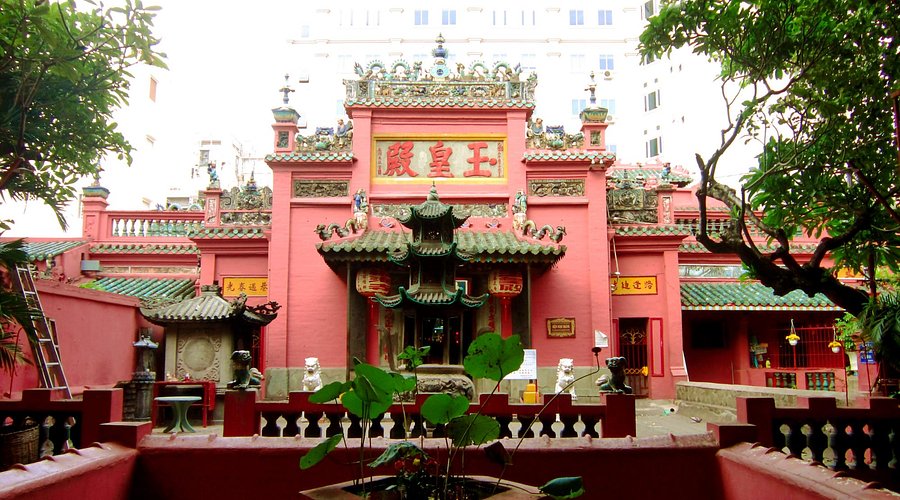
An Atmospheric Blend of Taoist Mysticism and Buddhist Symbolism
Built in 1909 to honour the supreme Taoist deity, the Jade Emperor (Ngọc Hoàng), this evocative temple is one of the most atmospheric spiritual sites in Ho Chi Minh City. Known also as Phước Hải Tự, or the Sea of Blessing Temple, it embodies a harmonious blend of Taoist and Buddhist traditions.
Step inside, and you’re immediately enveloped by the thick scent of incense (hương) drifting through the air. The dim interior is rich with phantasmal statues and shadowy carvings, lit by soft candlelight. The roof is adorned with ornate tile work, and many of the figures—ranging from divine warriors to celestial beings—are sculpted from reinforced papier-mâché, adding a ghostly texture to the temple’s quiet drama.
Main Sanctuary: At the heart sits the Jade Emperor himself, cloaked in imperial robes, surrounded by the Four Big Diamonds (Tứ Đại Kim Cương)—his towering guardians reputed to be as indestructible as diamonds.
Guardian Generals: On either side of the main altar are fearsome generals: one crushing a Green Dragon, the other trampling a White Tiger—symbols of chaos subdued by divine order.
Just left of the main sanctuary is a room presided over by Thanh Hoàng, the Chief of Hell, with his red horse standing nearby. Worshippers visit this chamber to reflect on morality, as wooden panels here depict the Ten Hells, each illustrating the torments awaiting those who commit evil. Nearby, a figure known as the City God wears a hat reading “At one glance, money is given,” inviting ritual offerings. Women often take part in a ceremonial act: placing money in a donation box, rubbing red paper on his hand, and waving it through a candle flame for blessings.
On the opposite side of the wall is a small yet captivating room featuring twelve ceramic women, each representing a year of the Chinese zodiac and symbolizing both virtues and vices. One, for example, holds a wine jug to reflect indulgence. Overseeing them is Kim Hoa Thánh Mẫu, the matron goddess of all women and children.
Upstairs, visitors find a serene hall dedicated to Quan Âm, the Buddhist Goddess of Mercy, facing an image of Đạt Ma, the bearded Indian monk who brought Zen Buddhism to East Asia.
Outside, a small pond teems with turtles, many marked with red inscriptions believed to bring good fortune. The pond adds a tranquil finish to the temple’s otherwise mysterious and intense atmosphere.
Admission: Free, though donation boxes are available throughout the temple.
Dress Code: Modest clothing is recommended—cover shoulders and knees out of respect.
Best Time to Visit: Arrive early in the morning to avoid crowds and experience the temple’s stillness.
Location: Centrally located in District 1, easily accessible via taxi or bike.
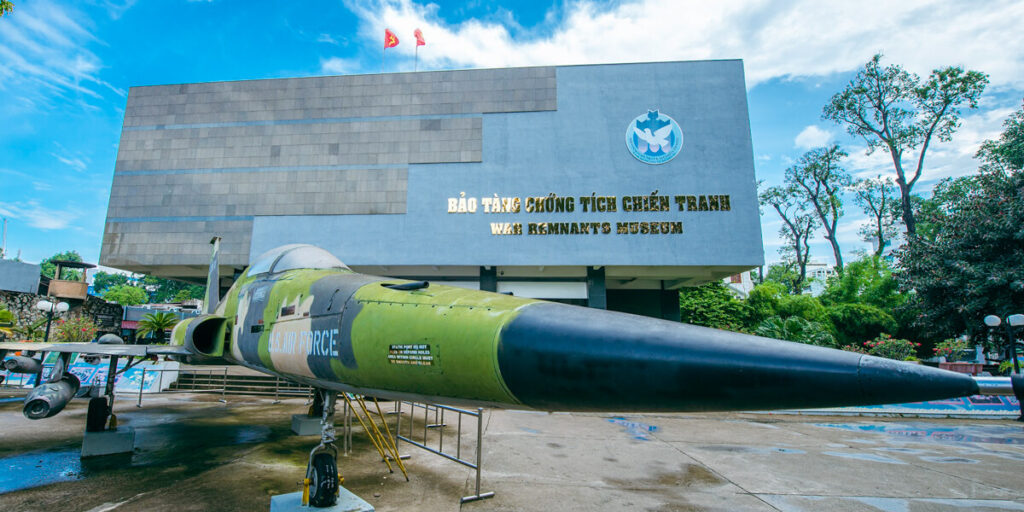
A Powerful Testament to Vietnam’s Wartime Past
To grasp the full impact of the US invasion of Vietnam, a visit to the War Remnants Museum is both essential and unforgettable. This deeply moving museum offers an unflinching look at the Vietnam War (known in Vietnam as the American War), documenting its devastating toll on the country’s civilian population through photographs, artifacts, and first-hand accounts.
Unlike many war museums, the War Remnants Museum gives voice to the victims of military aggression. While the narrative is presented primarily from a Vietnamese perspective, much of the harrowing visual documentation—such as the My Lai massacre, where over 500 unarmed civilians were killed by US troops—comes from American sources. This lends the museum a raw, sobering authenticity that transcends national boundaries.
Outdoors: The courtyard features decommissioned US tanks, helicopters, artillery, bombs, and infantry weapons—a stark reminder of the scale of warfare. One area recreates the brutal conditions of French and South Vietnamese prisons on Phu Quoc and Con Son islands, complete with ‘tiger cages’ and a chilling guillotine once used by French colonists.
Ground Floor: A collection of global anti-war posters, photographs, and messages of solidarity offers a more hopeful counterpoint, highlighting international resistance to the war.
Upper Floors: These house graphic photo essays of wartime atrocities—napalm bombings, Agent Orange’s toxic aftermath, and experimental weapons like flechettes. Be prepared: many of these images are extremely disturbing and emotionally intense.
Requiem Exhibition: A highlight of the museum, this photographic tribute—curated by renowned war photographer Tim Page—honours journalists and photographers who lost their lives covering the conflict. Featured are haunting works by Larry Burrows, Robert Capa, and many others, offering a deeply personal glimpse into the war through their lenses.
Originally named the Museum of Chinese and American War Crimes, the War Remnants Museum opened shortly after the end of the war. It is housed in the former US Information Service building and has evolved into one of Vietnam’s most visited and internationally respected institutions.
Admission:
Adults: 40,000 VND
Children (6–16): 20,000 VND
Children under 6: Free
Opening Hours: Daily, 7:30 AM–12:00 PM and 1:30 PM–5:00 PM
Languages: Exhibits include captions in Vietnamese and English
Time Required: At least 2 hours for a meaningful visit
Location: District 3, Ho Chi Minh City, easily accessible by taxi or Grab
Note: Due to the emotionally heavy nature of the exhibits, visitors may find it helpful to take breaks between floors. The museum encourages reflection, compassion, and a deeper understanding of Vietnam’s history—and the lingering impact of war.
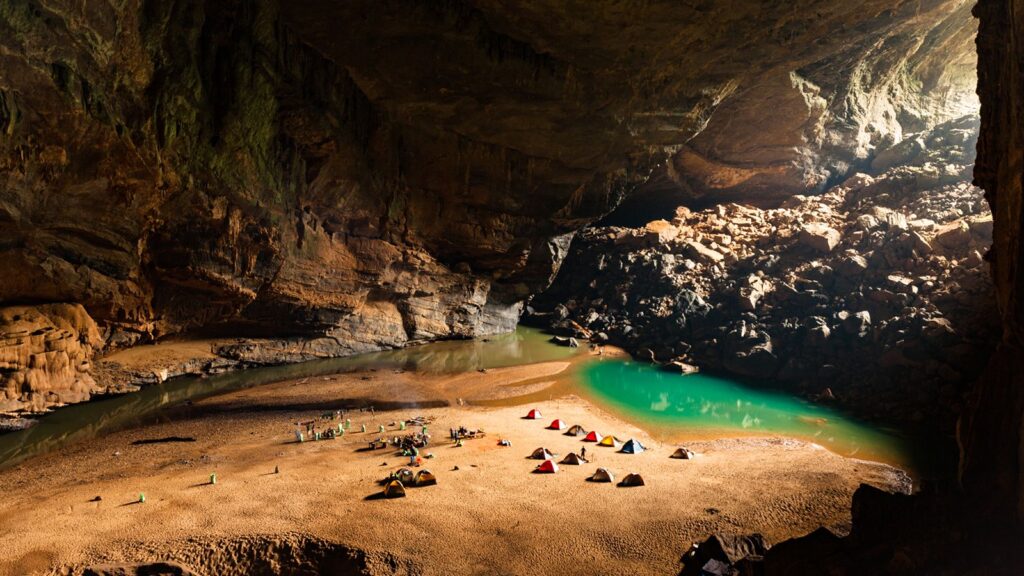
Phong Nha-Kẻ Bàng National Park, Vietnam
Tucked deep within the UNESCO-listed Phong Nha-Kẻ Bàng National Park, Hang Sơn Đoòng (meaning Mountain River Cave) holds the title of the world’s largest cave—a natural marvel of staggering proportions and otherworldly beauty. But this is not just a cave; it’s a rare and exclusive expedition reserved for only the most adventurous travelers.
Sơn Đoòng stretches over 5km in length, with caverns soaring 200 meters high and up to 150 meters wide—big enough to house a New York City block or even a Boeing 747. Giant skylights punch through the ceiling, bathing parts of the cave in natural light and nurturing surreal jungle ecosystems within. Inside, you’ll find:
Towering stalagmites reaching up to 80 meters (nicknamed the Cactus Garden)
Rare cave pearls as large as golf balls
Stunning rimstone pools
An underground river perfect for swimming
And the awe-inspiring Great Wall of Vietnam, a calcite wall once thought to be impassable
Though locals like Ho Khanh, a jungle hunter, had long known of Sơn Đoòng, its immense size wasn’t verified until a 2009 expedition led by British cave explorers. Khanh had originally stumbled upon the cave in the early 1990s while seeking shelter, but it took nearly two decades before the world truly grasped its scale and majesty.
Access is strictly limited. Only Oxalis Adventure, a reputable eco-tourism company based in Son Trach, is licensed to lead expeditions into the cave. Their four-day, three-night journey costs around US$3,000 per person, and spots are limited to just 10 trekkers per trip, ensuring a once-in-a-lifetime, small-group experience.
The expedition includes:
Challenging jungle treks
River crossings and technical caving
Expert guides, porters, and cooks
Camping inside the cave itself
Tour Season: January to August
Book early – due to strict quotas and high demand, trips often sell out months in advance.
Fitness required – the trek is strenuous; climbers unable to meet basic physical requirements may be turned back on day one.
Not ready for Sơn Đoòng? Oxalis also offers shorter, more accessible adventures to other incredible caves in Phong Nha-Kẻ Bàng National Park—like Hang En or Tu Lan—with stunning landscapes and fewer physical demands.
Hang Sơn Đoòng isn’t just a tour—it’s an expedition into one of the last truly wild places on Earth.
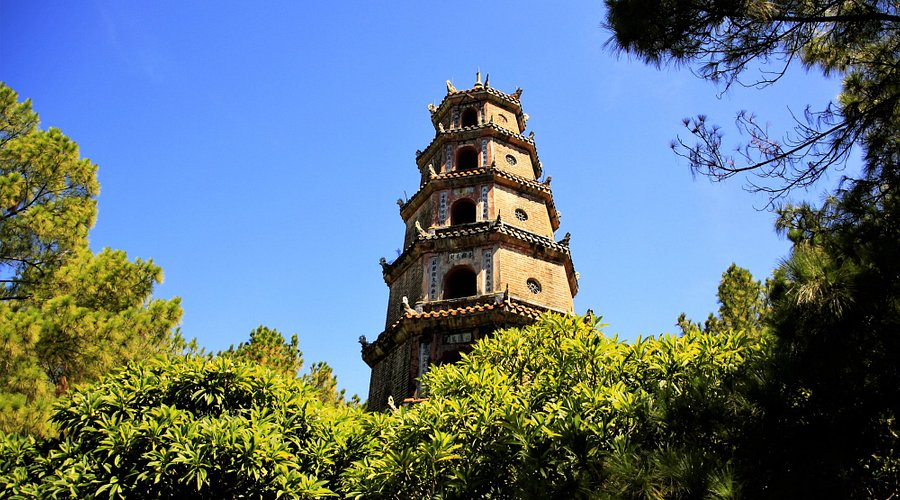
Perched on a hill overlooking the tranquil Perfume River (Song Huong), just 4km southwest of Hue’s ancient Citadel, Thien Mu Pagoda is one of Vietnam’s most revered religious sites. With its striking seven-storey tower and storied past, the pagoda stands as a powerful symbol of Hue’s spiritual and political heritage.
Founded in 1601 by Nguyen Hoang, the governor of Thuan Hoa province, Thien Mu has weathered centuries of rebuilding and political upheaval. Its iconic octagonal tower, Thap Phuoc Duyen, rises 21 meters high and was commissioned in 1844 by Emperor Thieu Tri. Each level of the tower honors a manushi-buddha—a Buddha who appeared in human form.
Over the years, the pagoda has also played a prominent role in Vietnam’s political life. In 1993, it was the site of a dramatic act of protest when a man self-immolated at the pagoda while chanting “Buddha,” drawing global attention.
To the right of the tower stands a pavilion housing a stele (dating from 1715), perched on the back of a massive marble turtle, symbolizing longevity.
To the left, a hexagonal pavilion shelters a giant bell cast in 1710, weighing over 2 tons (2052kg) and said to be audible from 10km away.
Passing through the ornate gateway, visitors arrive at a hall dedicated to the Celestial Lady (Thien Mu), from whom the pagoda takes its name. A board above the central entrance reads 靈姥寺, meaning Divine Old Woman Temple, in her honor.
Beyond the gate lies a serene courtyard and the main sanctuary, where statues of the Laughing Buddha and a sacred triad—A Di Da (Buddha of the Past), Thich Ca (Sakyamuni, the historical Buddha), and Di Lac (Buddha of the Future)—invite quiet contemplation.
Entry: Free of charge
Best time: Visit early in the morning to avoid crowds
Getting there: Many visitors arrive by boat along the Perfume River, a scenic and peaceful way to approach the site. Group tours range from $5 to $20, bookable via most hotels and travel agencies in Hue.
Thien Mu Pagoda is not only an architectural gem but a living testament to Vietnam’s cultural resilience and religious devotion.
WhatsApp us